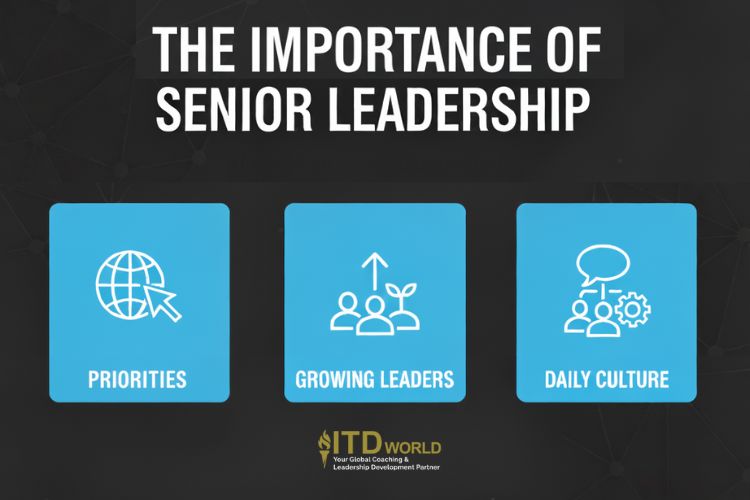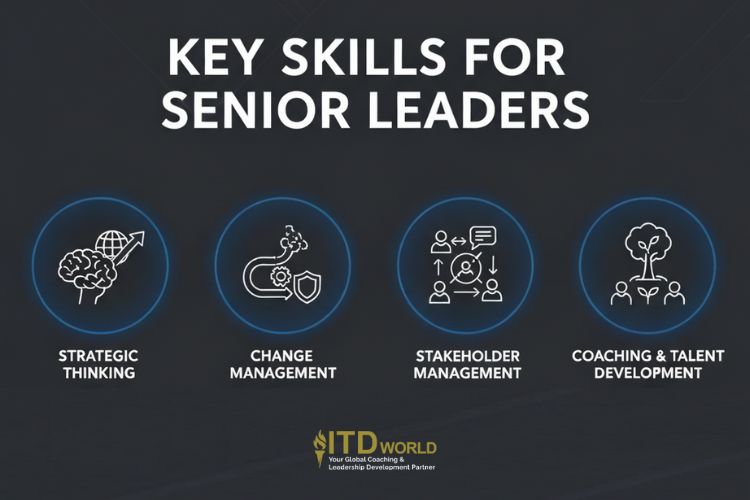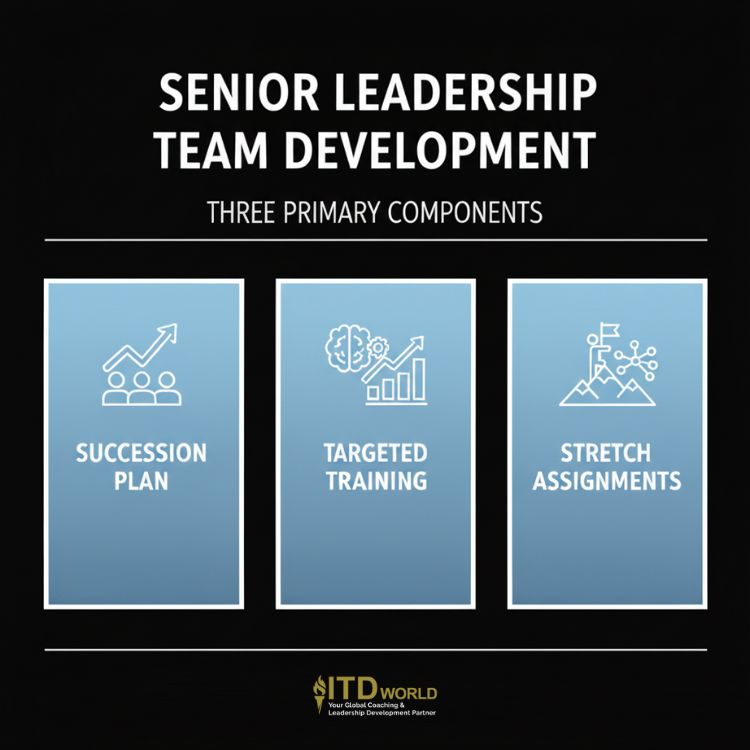Learn about the unique role of senior leadership team, the core skills required, plus a practical pathway to cultivate one.
Why do brilliant executive strategies so often fail to translate into effective frontline action? The answer, as it turns out, frequently lies in the “missing middle” – the critical gap between the C-suite’s vision and the daily work of the organization. This is where the senior leadership team plays its most vital role.
|
Author: Jonathan M. Pham |
Highlights
- The role of senior leadership is to translate the executive team’s long-term vision into actionable strategies and operational results by leading major functions, managing resources, developing other leaders, and driving key strategic initiatives within an organization.
- Senior leaders are expected to deliver functional results, grow their teams, and promote cross-functional collaboration to achieve success through broader organizational impact rather than individual contributions. As such, they need to demonstrate skills such as strategic thinking and business acumen (to align their function with company goals), change management (to guide teams through transitions), influence and stakeholder management (to achieve cross-functional buy-in), and talent development abilities (to build future leaders).
- To get promoted to senior leadership, you must consistently excel in your current role while demonstrating a broader business perspective, actively seek cross-functional experiences, and cultivate both mentors for guidance and sponsors for advocacy.
- High-performing organizations intentionally cultivate their senior leadership teams through strategic succession planning, targeted development programs focusing on senior-level skills, and challenging “stretch” assignments to prepare individuals for greater responsibilities.
What is Senior Leadership?
Senior leadership is the essential layer of leaders responsible for translating the high-level, long-term vision of the executive team into actionable strategies and operational results. Their core purpose is to lead entire functions, departments, or major business units, ensuring that day-to-day execution is aligned with the company’s overarching strategic goals. In other words, they are the critical transmission system that converts the executive “why” into the frontline “how.”
While specific titles vary between organizations, the key responsibilities of senior leadership typically include:
- Leading a major function or department: Overseeing entire departments such as sales, engineering, marketing, or human resources.
- Managing significant budgets and resources: Allocating capital and personnel effectively to support strategic objectives.
- Developing other leaders: Actively coaching and mentoring mid-level managers to establish the organization’s future leadership pipeline.
- Driving key strategic initiatives: Owning and executing major cross-functional projects crucial to the company’s success.
These roles often carry titles such as Vice President (VP), Director, Head of Department, or General Manager.

Senior Leadership vs. Senior Management vs. Executive Leadership
Many times, people refer to senior leadership using terms such as senior management, top management, executive management, upper management, etc. However, it’s worth noting that there are certain nuances between these terms, specifically in their scope and orientation – from running the business to growing it.
| Term | Primary Focus | Example Role |
| Senior Management | Operational Efficiency: Managing processes, allocating resources, and ensuring tasks are completed correctly. The focus is on “doing things right.” |
Plant Manager, Regional Operations Manager
|
| Senior Leadership | Translating Strategy into Action: Developing people, driving functional excellence, and ensuring their teams are focused on the right priorities. In other words, it is about “doing the right things.” |
Vice President of Sales, Director of Engineering
|
| Executive Leadership | Setting Enterprise-Wide Vision: Determining the long-term direction, strategy, and goals for the entire organization. Their concern is on “deciding what the right things are.” |
Chief Executive Officer (CEO), Chief Financial Officer (CFO)
|
The Importance of an Effective Senior Leadership Team
The senior leadership team is far more than a simple management layer; it has a direct, measurable, and profound impact on every aspect of the business. While the executive team sets the destination, it is the senior leadership team that pilots the ship, navigates the challenges, and ensures everyone is rowing in the same direction. Their effectiveness is where the “rubber meets the road,” determining whether a brilliant strategy becomes a market success or a forgotten initiative.
An investment in developing this layer of leadership yields clear, tangible returns:
- Driving strategic alignment
The primary role of senior leaders is to ensure that the efforts of their departments and teams are tightly aligned with the company’s most important strategic priorities. When this link is weak, businesses suffer from what is known as the “strategy-execution gap.” In fact, research has shown that a leading cause of project failure is a lack of consistency with organizational strategy, leading to wasted resources and missed opportunities.
- Growing future leaders
Senior leaders are the primary developers of an organization’s future leadership pipeline. They are responsible for coaching and mentoring the mid-level managers who will eventually step into more senior roles. This is a critical function for long-term health, given that strong internal mobility and transparent career pathways are major drivers of talent retention.
- Shaping the daily culture
While executives may define the desired corporate environment, it is the senior leaders who determine the actual culture experienced by the majority of employees. Their daily actions, communication style, and priorities set the tone for their entire function. This is supported by Gallup’s study, which concludes that the manager is the single most influential factor in a team’s level of engagement, accounting for up to 70% of the variance.

Conversely, when the senior leadership layer is weak or underdeveloped, the entire organization suffers. The consequences are severe and predictable:
- Strategic drift: Brilliant executive strategies fail to gain traction and are never properly executed, leading to stagnation.
- A talent drain: High-potential employees, seeing no path for growth and enduring poor management, will eventually leave for better opportunities.
- Toxic sub-cultures: Inconsistent leadership allows unhealthy, siloed, or unaccountable behaviors to emerge within departments, undermining overall dynamics and collaboration.
Ultimately, investing in the development of the senior leadership team is one of the highest-leverage actions an organization can take to ensure its long-term success.

The Senior Leader’s Mandate: Common Expectations
Moving into a senior leadership role represents a fundamental shift in responsibility and perspective. Success is no longer measured solely by individual expertise or the performance of a small team, but by one’s ability to deliver results through larger, more complex functions and in partnership with their peers.
While the specific KPIs may vary, the effectiveness of a senior leader is generally judged against three primary criteria:
- Delivering functional results: The leader must ensure their department or function consistently meets its operational and financial targets. They are accountable for the performance and output of their entire area of responsibility.
- Developing people: A senior leader’s long-term value is determined by their ability to establish a high-performing team and a strong succession pipeline. They are expected to be talent magnets who can coach, mentor, and grow the next generation of leaders within the organization.
- Promoting cross-functional collaboration: At this level, success is rarely achieved in a silo. One needs to look beyond their own department and partner closely with their peers across the organization to break down barriers and visualize shared goals.

Key Skills for Senior Leaders
Meeting the above-mentioned high expectations requires a more sophisticated and strategic skillset than what was needed at the mid-management level:
-
Strategic thinking & business acumen
This is the ability to realize the “big picture” of the business and connect the work of one’s own function to the company’s overall strategy and financial health. It involves moving from a tactical to a strategic mindset.
As a senior leader, one needs to constantly ask strategic questions, such as: “How does my team’s current work directly contribute to our company’s top three strategic goals?” or “What market trends will impact our function in the next 18 months, and how must we prepare?”
Read more: Leadership Self-reflection – Key to Long-term Excellence
-
Change management
Senior leaders are the primary agents of change within an organization. As such, they must be adept at leading their teams through complex transitions – whether it’s a new technology implementation, a corporate restructuring, or a shift in business strategy – with clarity, empathy, and resilience.
Read more: Resistance to Change in the Workplace – How to Overcome It
-
Influence & stakeholder management
As mentioned above, success at this level mostly depends on securing buy-in from people over whom you have no formal authority. As a result, one needs to demonstrate the ability to effectively influence those in other departments, manage expectations with executive leadership, and maintain strong relationships with key external partners.
-
Coaching & talent development
Excellence in leadership goes far beyond simple management; at its core, it requires the practice of actively coaching direct reports to improve their performance, identifying high-potential individuals within their teams, and creating specific growth opportunities/ career paths to build a strong bench of future leaders.
The leap to senior leadership requires an evolution from being a functional manager to becoming a strategic, people-focused business leader capable of delivering results at scale.

How to Get Promoted to Senior Leadership
Making the leap from a managerial role to a senior leadership position requires more than just being excellent at your current job. It requires demonstrating the mindset, business acumen, and visibility that prove you are ready to operate at the next level.
- Excel in your role, while thinking beyond it
Consistent high performance is the “ticket to the game”; in fact, it’s the absolute prerequisite for consideration. However, to advance, you must demonstrate that you understand how your work fits into the bigger picture. In other words, it means not just hitting your department’s targets, but also being able to articulate how your team’s performance impacts the company’s overall revenue goals, market position, and customer satisfaction. In meetings, make contributions that show you are thinking about the entire business, not just your own functional concerns.
- Actively seek cross-functional experience
Senior leaders must be able to break out of functional silos and collaborate effectively across the enterprise. The best way to prepare for this is to gain hands-on experience working with other parts of the organization before you are promoted.
Example: Volunteer to lead or participate in a high-visibility, cross-functional project, such as a new product launch or a process improvement initiative that involves teams from operations, marketing, and finance. This not only expands your business acumen but also dramatically increases your network and your visibility to other senior leaders.
- Cultivate both mentorship & sponsorship
It is crucial to understand the difference between these two types of relationships – and to actively seek both.
-
- A mentor talks to you. Find an experienced leader you admire who can provide you with confidential advice, help you navigate challenges, and guide your skill development.
- A sponsor talks about you. A sponsor is a senior, influential leader who believes in your potential and will actively advocate for you in high-level talent discussions and succession planning meetings. Sponsorship is earned through consistent high performance and by making your career aspirations known to those who can open doors for you.
Read more: How to Build a Lasting Leadership Legacy

How to Cultivate Your Senior Leadership Team
While individuals are indeed responsible for deciding their own careers, high-performing organizations do not leave the development of their senior leadership to chance. They recognize that building a deep bench of ready and capable leaders is a strategic imperative – one that requires an intentional, systematic approach.
-
Implement a strategic succession plan
The first step goes far beyond simply creating a list of names for emergency replacements. A true succession plan is a dynamic process of proactively identifying talent early, assessing their readiness for more senior roles, and mapping out a clear development path to help them close their skill gaps.
For the above-mentioned purpose, organizations should conduct regular talent review meetings where current leaders discuss potential successors for critical roles. The evaluation should be based not just on their current performance, but on their demonstrated potential to acquire the strategic thinking and cross-functional influence skills required at the senior level.
-
Invest in targeted, level-appropriate development
The competencies that make a great manager are different from those required to be a successful senior leader. Hence, organizations must provide development initiatives specifically designed to bridge this critical gap.
Example: Instead of offering generic management training, it is much better to invest in programs for their high-potential cohort that focus on the core senior leadership skills discussed earlier – strategic business acumen, leading through complex change, and enterprise-wide influence. This ensures that participants are being prepared for the challenges they will actually face in a more senior role.
Read more: Employee Skill Development – Boost Your Bottom Line
-
Utilize “stretch” assignments as a proving ground
Leadership is best learned through applied experience. The most effective way to both test and grow potential senior leaders is to give them carefully selected opportunities to lead initiatives outside of their day-to-day comfort zone.
Example: Identify a high-potential director from one function (e.g., Marketing) and make them in charge of a critical, cross-functional strategic initiative (e.g., a project to improve supply chain efficiency). This “stretch” assignment forces them to learn about other parts of the business, manage stakeholders over whom they have no formal authority, and think strategically about the entire enterprise – providing invaluable experience for a future role.

Common Challenges That Senior Leaders Face
Ascending to a senior leadership role brings a new and more complex set of challenges. The issues become less about technical execution and more about navigating intricate human and organizational dynamics.
- Navigating cross-functional conflict
Senior leaders must often champion initiatives that require resources, time, or cooperation from other departments, leading to natural conflicts over priorities, budgets, or timelines.
Solution: The key is to shift from a departmental mindset to an enterprise-wide perspective; this requires strong negotiation and influence skills to find common ground.
Example: Instead of arguing for what is best for “my department,” one should aim to frame the conversation around shared organizational goals by saying something like, “I understand this initiative will be a heavy lift for your team, but it is crucial for hitting our company-wide customer retention target. Let’s work together to find a solution that helps us all succeed.”
- Balancing long-term strategy with daily operations
Senior leaders face a constant tension between the need to think strategically about the future and the pressure to ensure the smooth execution of day-to-day operations. It is easy to get pulled into the “tyranny of the urgent” and neglect strategic work.
Solution: This requires mastering two disciplined practices: prioritization and empowering delegation. A senior leader must be disciplined about blocking out “strategic thinking” time on their calendar and protecting it. They must also trust and empower their managers to handle most operational issues, shifting their own role from being the primary problem-solver to being the coach who facilitates other problem-solvers.
- Leading former peers
Being promoted to lead a team of former colleagues is one of the most common and personally difficult transitions. The leader must now evaluate, direct, and hold accountable the same people who were once their friends and equals.
Solution: This requires a conscious and respectful resetting of boundaries and expectations. It is crucial to address the change directly and professionally.
Example: A newly promoted leader should have an open conversation with their team early on. They might say, “I deeply value the relationships we have, and that won’t change. At the same time, my role is different now, and my primary responsibility is to ensure the success of the entire team. This means I’ll have to make tough decisions and hold us all to high standards, including myself.”
Read more: Human Leadership in a Digital World
How ITD World Can Help Develop Your Senior Leadership Team
At ITD World, we specialize in equipping leaders for the unique challenges and responsibilities of senior-level roles. Our programs are designed to cultivate the strategic mindset, influential communication, and people development skills necessary to translate strategy into sustainable results.
- The Senior Leadership Development Program (SLDP): Our premier program is an immersive experience designed specifically to pass on the strategic and leadership capabilities required at this level. The curriculum focuses on mastering critical skills such as leading through complex change, driving cross-functional influence, and enhancing business acumen.
- Executive coaching: We provide confidential, one-on-one coaching to help individual leaders navigate their unique challenges, accelerate their transition into a new role, and refine their personal leadership style for maximum impact.
- Customized in-house solutions: We partner with your organization to design and deliver bespoke programs that contribute to establishing a robust and aligned senior leadership pipeline. These solutions are tailored to your company’s specific industry, culture, and strategic goals to ensure a memorable and relevant learning experience.
Ready to close the gap between strategy and execution? Contact ITD World today to learn more about our Senior Leadership Development Programs and how we can partner with you to visualize your future success!
Other resources you might be interested in:
- Compassionate Leadership: Beyond Simply ‘Being Nice’
- Transformational Leadership: Inspiring Change & Growth
- Servant Leadership: A Transformative Approach to Management
- Leadership Philosophy: How to Define Your True North & Follow It

